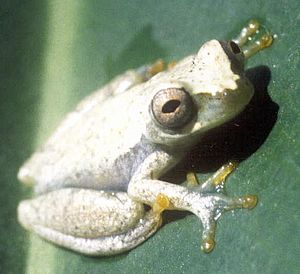Dendropsophus luteoocellatus facts for kids
Quick facts for kids Dendropsophus luteoocellatus |
|
|---|---|
 |
|
| Conservation status | |
| Scientific classification |
The Dendropsophus luteoocellatus is a small frog that belongs to the Hylidae family, also known as the tree frog family. This special frog is found only in Venezuela, which means it is endemic to that country.
It lives in many different places, like warm, wet lowland forests and cooler, moist mountain forests. You can also find it near freshwater marshes, in grassy fields, in gardens, and even in city sewer systems or ponds.
Contents
About the Yellow-Eyed Tree Frog
This frog is often called the Yellow-Eyed Tree Frog because of its bright eyes. It's a fascinating creature that helps us understand the amazing variety of life on Earth. Scientists first described this species in 1927.
Where Does It Live?
The Yellow-Eyed Tree Frog makes its home in various parts of Venezuela. It prefers places that are warm and humid. You might find it hopping around in:
- Tropical lowland forests, which are dense and full of trees.
- Tropical mountain forests, where the air is a bit cooler and misty.
- Wetlands like marshes, which are important for many types of wildlife.
- Even in areas changed by people, like farms, gardens, or city ponds.
What Does It Look Like?
Like many tree frogs, the Dendropsophus luteoocellatus is small and has special pads on its toes. These pads help it climb trees and cling to leaves. Its skin is usually a shade of green or brown, helping it blend in with its surroundings. The most striking feature, as its name suggests, is often its yellow eyes, which stand out against its body.
Why Are Frogs Important?
Frogs like the Yellow-Eyed Tree Frog play a big role in their ecosystems. They eat insects, which helps control insect populations. They also serve as food for other animals, like birds and snakes. Because their skin is very sensitive to their environment, frogs are often seen as "bio-indicators." This means if frogs are doing well, it's a good sign that the environment is healthy too.
See also

- In Spanish: Ranita ocelada para niños


